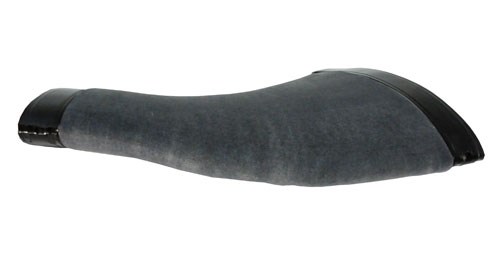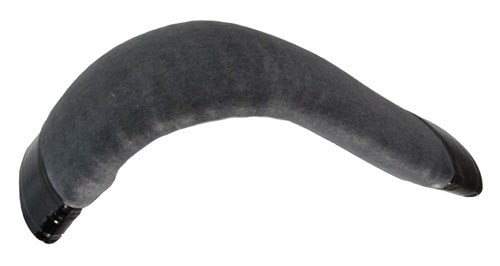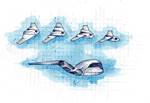SMPs: Reshaping old realities
Moving quickly from science fiction to science fact, shape-memory polymer composites show great potential in aerospace applications.
Shape-memory polymers (SMPs) have stimulated both excitement and research over the past two decades in almost every industry segment, as researchers work to harness their potential in unique solutions. As the name suggests, SMPs are a class of “smart” materials that, in response to an external stimulus, experience a modification of their polymer structures, enabling a predictable change from one geometrical shape to another.
Most common among these “shape shifters” — and of greatest interest to composites manufacturers — are thermally activated SMPs. These respond to heat applied from an external source. The change in material temperature modifies the molecular bonds within the structure to change their mechanical properties (see the sidebar below or click on "Shape shifters: The molecular basics," under "Editor's Picks," at right).
Most newsworthy are SMPs designed to expand or unfold large orbiting space structures previously folded and packed tightly within small payload fairings atop space launch vehicles. “Deployment is where most people think about shape-memory polymers,” explains Patrick Hood, president, Cornerstone Research Group (CRG, Dayton, Ohio). “Shape-memory polymers store energy, and this energy can be released to deploy a structure,” he explains.
Currently, CRG and competitor Composite Technology Development Inc. (CTD, Lafayette, Colo.) each have SMP composite hinges undergoing tests aboard the International Space Station. CRG’s hinges employ material from its family of Veriflex SMPs. CTD has been using spacecraft-deployable structures as a proving ground for its TEMBO thermoset SMP-based composites for several years. Currently, the latter also is using SMP composites to develop other passively deployable systems for orbital vehicles, including a lightweight solar array and, using its TEMBO materials, large-aperture high-frequency antenna reflectors.
Morphing wings: Still waiting
Closer to Earth, much research has been done on morphing-wing technology, which enables an increase in wing area to optimize lift at slow speeds, yet also permits a decrease in wing area and alteration of wing shape to facilitate flight at higher speeds. Ideally, morphing-wing design integrates a mechanical structure, a seamless skin and actuators. Although morphing systems do not require SMPs, these materials are an attractive option for creating an adaptable, seamless wing surface. Unfortunately, the most notable effort toward this end, the Morphing Aircraft Structures program sponsored by the Defense Advanced Research Projects Agency (DARPA) and the Air Force Research Laboratory’s Air Vehicles Directorate (Wright-Patterson AFB, Ohio), has ended, but CRG’s Hood believes SMP morphing wingskins are “a technology ahead of its time in relation to the rest of the aircraft.” (See "The changing shape of future aircraft," under Editor's Picks.")
During the program, CRG fabricated a subscale, carbon fiber-reinforced Veriflex SMP composite wing prototype for which, Hood maintains, the SMP skin has been proven: When heated, it can be reshaped by the internal wing structure and will maintain that shape when cooled. When reheated, the skin regains its original shape. He admits, however, that there remain a number of practical challenges, not the least of which is optimizing the delivery of heat into an SMP while it is cooled significantly by inflight airflow.
Further, there is the issue of aerodynamic loads. “Aircraft today carry much of their loads in the skin,” explains Hood. “With a morphing aircraft, you’re essentially ‘adding rubber’ to the skin, which will not carry significant loads when transforming shape,” he says. Moreover, “the entire substructure of a morphing aircraft must be redesigned to look more like the skeleton of a bird than the framework of a conventional aircraft.”
Research funded by the U.S. Air Force seeks to address such issues on unmanned aerial vehicles (UAVs), a natural first step toward practical implementation of wing morphing technology. The program’s focus is to develop solutions that will trigger morphology in SMP wingskins under typical flight conditions experienced by UAVs that range in weight from 10 to 5,000 lb (4.5 to 2,268 kg). The technology will optimize the craft’s ability to loiter over its target, yet it will be able to fly faster to targets.
A prime goal is faster, more efficient heating. According to the USAF program description (AF093-127): “Current resistive heating methods used to trigger SMPs cannot overcome the convective heating losses in flight to effectively trigger the transition from a rigid to labile skin (two to three orders of magnitude change in SMP skin modulus).”
During the first of the program’s three phases, ADA Technologies Inc. (ADA, Denver, Colo.) was awarded $100,000 for early-stage research into its concept, which combines nanotechnology, SMP, thermal modeling and a volumetric or bulk heating concept.
“Our approach is based on being able to heat the entire material at the same time,” says Steven Arzberger, senior research scientist and project manager at ADA. He believes that, given the right conditions, SMPs are capable of enabling a substantial wing shape change while still providing sufficient stiffness to carry aerodynamic loads.
“With a resistive heater, you can heat up the localized surrounding region very rapidly,” says Arzberger. “However, at the points at which these heaters are embedded, the material will experience the highest levels of heat generation while relying on transfer of thermal energy to heat the surrounding regions.” This method, he adds, is counterintuitive because polymers are naturally thermal insulators. “We’re proposing the use of a wireless energy coupling in the wingskin that would allow trigger temperatures to be reached much more rapidly,” he explains.
ADA has developed an SMP family that uses nanotechnology to improve the thermal conductivity at the interface between the nanoparticles and the SMP resin, thereby increasing the heat-transfer efficiency. According to ADA, the low stiffness and strength of SMPs during heating can be counterbalanced with reinforcements, such as chopped carbon, glass or aramid fibers. And, the SMP composite’s thermal and electrical conductivities reportedly can be improved, using (among other materials) carbon nanotubes, nanofibers and nanopaper.
Inflatable, removable mandrels
SMPs also are improving mandrel performance in the production of hollow composite components with complex geometries. “When you’re creating an entrapped part, such as a piece of ductwork on an aircraft, the tool necessary on the inside of that ductwork during layup cannot easily be removed once layup is completed,” explains Hood.
To address this situation, CRG has developed an SMP that operates first as a near net-shaped, rigid layup mandrel and then, when the composite layup and mandrel are inserted into the mold and subjected to heat and pressure, the SMP softens, becoming flexible enough to inflate like a bladder. When inflated, the SMP compacts the material against the inside of the mold. It remains flexible and inflated during cure, but afterward, the mold is cooled and as it is depressurized, the mandrel returns to its uninflated state for easy removal and reuse.
The inflatable SMP mandrel promises several advantages over existing systems. “The technology being used today is a silicone bladder with a silicone foam or a wash-away mandrel,” explains Hood. “However, these technologies can result in expensive parts, low yield or size limitation.” Hood says SMP tooling can reduce molding costs by 80 percent, mostly in labor savings. “We have demonstrated our SMP tooling in the production of a small fuselage, which has been test flown, and we are now moving into full production,” he adds.
Beyond thermal activation
Hood sees thermally activated SMPs as merely a launching point for the whole smart materials movement. “We are now starting to understand how these materials respond to stimulus, transfer information and then modify their properties,” says Hood. By altering the chemistry of the SMP (generally, using fillers with specific traits) developers of SMPs can harness a stable of smart materials with a range of external stimuli. CRG, for instance, has a light-activated material that, when exposed to a certain color of light, becomes an elastomer and then, exposed to another color, returns to its rigid state. Reportedly, SMPs also can be tuned to react to electrical fields, magnetic fields, infrared lasers, humidity and other stimuli.
To do this, however, will require greater knowledge. “Today, making a shape memory polymer is pretty straightforward,” says Hood. “But making one that has engineered properties that can actually be integrated into a system is much harder,” he adds.
“Having shape-memory polymers as a tool makes us think in a different way about solving problems,” says Hood. In areas such as propulsion, ammunition or food storage, for example, measuring the total exposure to heat and humidity is critical to determining the readiness or freshness of the product. “By controlling the way in which our shape-memory material relaxes as a function of temperature and humidity, and then by extracting the history over the cumulative exposure,” he explains, “we are able to create a zero-power, long-life, inexpensive sensor that’s visual and easy to read.” This technology is by no means the stuff of fantasy. Hood points out that it is now in the prototype phase and is moving rapidly toward full-scale implementation.
Although numerous challenges remain — convenient triggering of shape-memory, for one — SMP research is progressing rapidly. Hood believes it is “time for us as a community to start building a toolkit necessary to fully take advantage of these nonlinear materials.”
Read Next
The changing shape of future aircraft
"Morphing" is no longer just for the birds.
Read MoreAll-recycled, needle-punched nonwoven CFRP slashes carbon footprint of Formula 2 seat
Dallara and Tenowo collaborate to produce a race-ready Formula 2 seat using recycled carbon fiber, reducing CO2 emissions by 97.5% compared to virgin materials.
Read More














.jpg;maxWidth=300;quality=90)




